
8 minute read
Postal Stationery : Ian McMahon
Postal Stationery
Welcome to the postal stationery column for May 2021. This month’s column looks at Tonga aerogrammes and free prepaid postcards from Canada Post and Australia Post.
Tonga Aerogrammes
Pacific Islands such as Tonga, Fiji, the British Solomon Islands and New Zealand began using air mail lettersheets known as ‘Air Mail Lettercards’ from around 1944. These lettersheets were unstamped (or formular) forms which required adhesive stamps to be added to pay postage.
The Tongan ‘air mail lettercards’ were of a similar design to those used in Fiji, British Solomon Islands and New Zealand except that they were inscribed ‘TONGA AIR MAIL LETTER CARD’. Figure 1 shows a form similar to that used in New Zealand in about 1945. They were most likely printed in New Zealand and were sold at post offices for a small charge. The forms show some variation in colour and other details so that there were likely a number of printings. Unlike most countries Tonga did not set a uniform postage rate (or rates) for ‘air mail letter cards’. For example, in 1 November 1950, the postage rates for air mail lettercards varied from 3d for Fiji, 5d for Australia, 4d for New Zealand, 8d for the UK (via Australia, 1/2 via USA), 8d for USA and up to 1/2 which was the rate to many countries in South America. Figure 2 shows an ‘Air Mail Lettercard’ used in 1950 from Nukualofa to
Figure 1 Tonga Air Mail Lettercard Figure 2 Air Mail Lettercard used in 1950 from Nukualofa to Canada Figure 3 Formular Aerogramme with ‘TONGA POSTAL ADMINISTRATION’

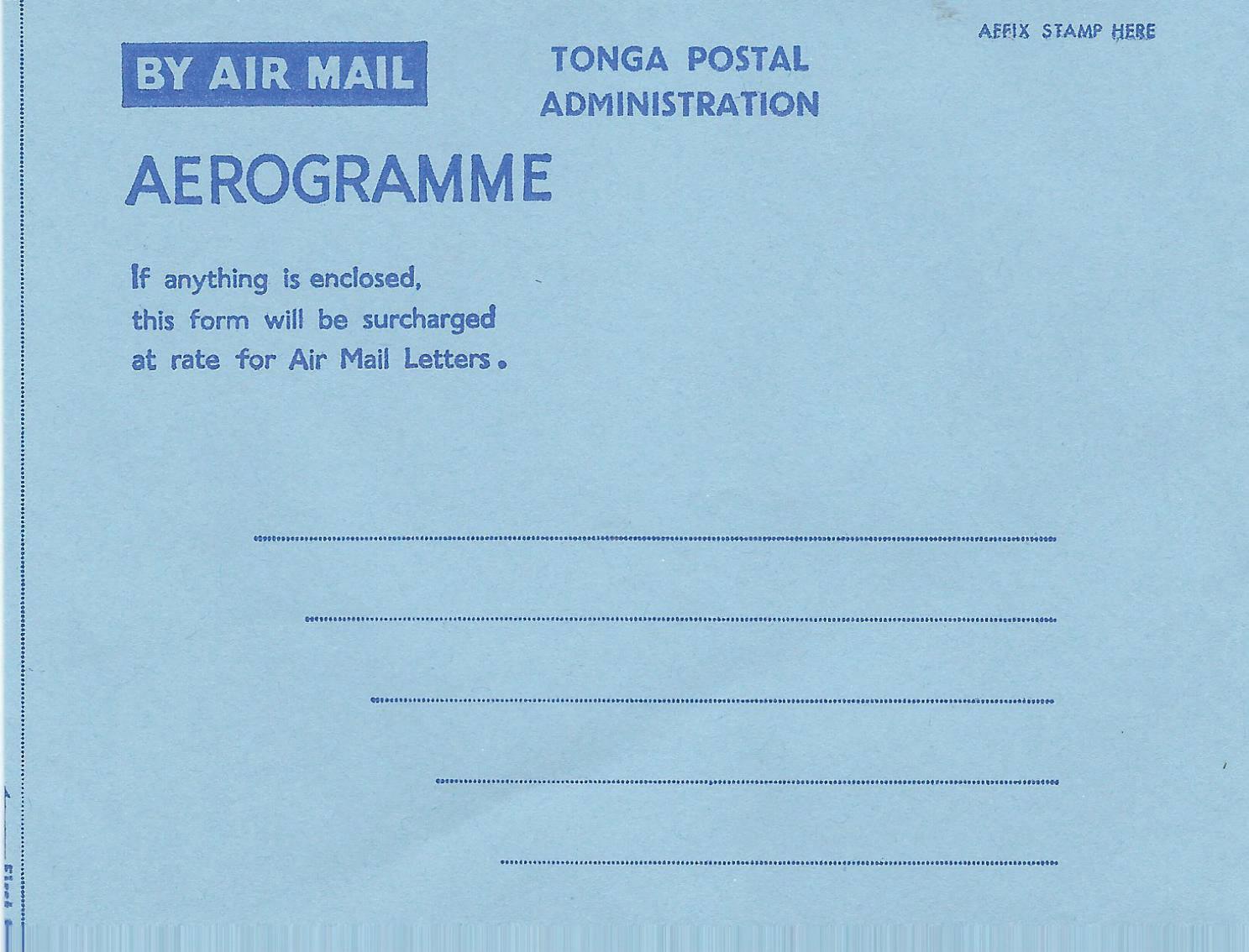
Ian McMahon
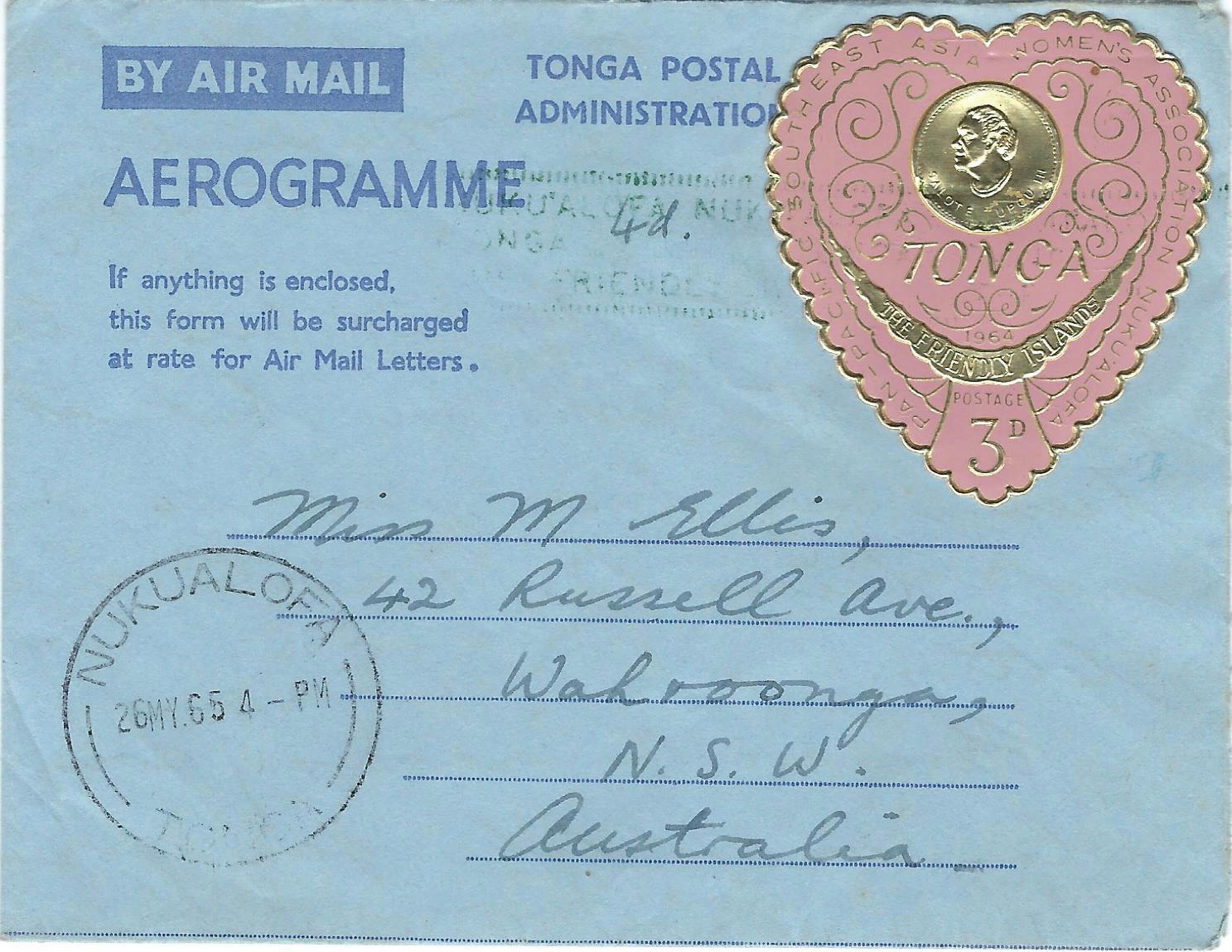

Montreal in Canada with 8d paid by adhesive stamps. On 1 November 1953 the rate to the United Kingdom became 9d. In early 1960 the rates were increased: Australia 7d, Fiji 6d, New Zealand 6d, USA 10d, UK 10d and maximum up to 1/3.
In about 1962, forms were issued inscribed ‘aerogramme’ as shown in Figure 3 with ‘TONGA POSTAL ADMINISTRATION’ in a design similar to that used in New Zealand. Figure 4 shows an example used from Nukualofa to Australia in 1965 with a 3d stamp affixed (likely underpaid). There were a number of variations of these forms with one issue being on forms produced by the New Zealand stationery company, Croxley, with the Croxley logo on the reverse of the form.
When decimal currency (100 seniti=1 Pa’anga) was introduced in 1967, formular aerogrammes were sold at post offices for 1s and the aerogramme rates were: within the Kingdom 2s, Australia 6s, Fiji 5s, New Zealand 6s, USA 7s, and UK 10s with a maximum rate of 13s.
Figure 5 shows a Tonga Postal Administration aerogramme with Croxley logo on the reverse used from Nukualofa to Australia in 1967 with 5s in adhesive stamps (a 1s stamp is affixed to the back of the form). One attraction with the formular aerogrammes of this period is the commercial use of Tonga’s early self-adhesive stamps. The first stamped aerogramme was issued in 1970. The 9s aerogramme (Figure 6) depicted a stamp showing Tongan Tapa
Figure 4 Tongan Formular Aerogramme used from Nukualofa to Australia in 1965. Figure 5 Tonga Postal Administration aerogramme with Croxley logo used from Nukualofa to Australia in 1967 Figure 6 9s Tongan Tapa aerogramme
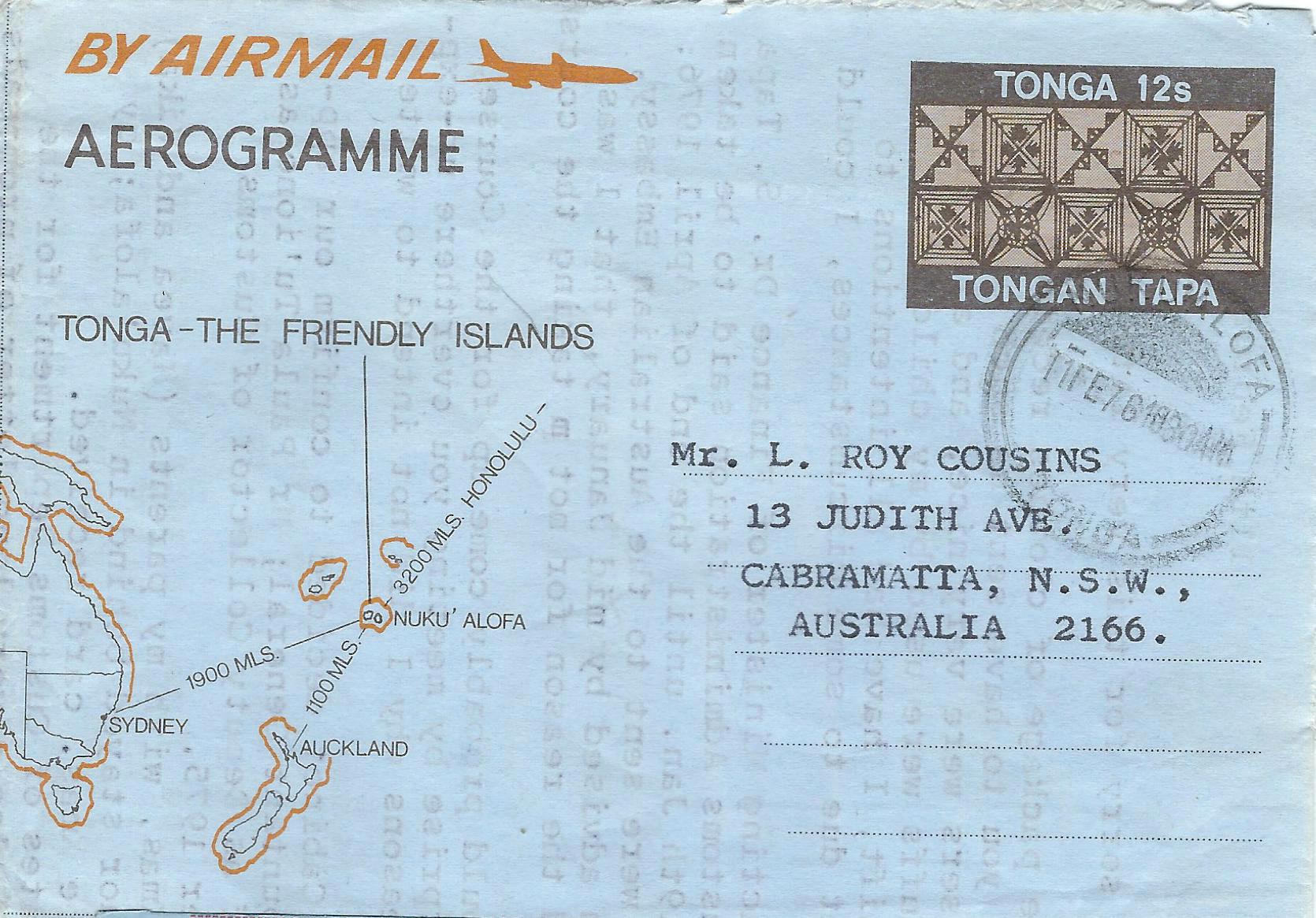
Postal Stationery


with a design on the left showing the location of Tonga in the South Pacific. The form was 122 x 96 mm on light gray-blue paper. A later printing was on grey paper. TONGAN TAPA is a barkcloth made in Tonga and other Pacific islands. It can be decorated by rubbing, stamping, stencilling, smoking or dyeing. The patterns of Tongan tapa usually form a grid of squares, each of which contains geometric patterns with repeated motifs such as fish and plants, for example four stylised leaves forming a diagonal cross. The bark of dye-fig and later the paper mulberry tree. Traditional dyes are usually black and rust-brown, although other colours are known. In former times the cloth was primarily used for clothing, but now cotton and other textiles have replaced it. Tapa is often worn on formal occasions such as weddings. Other uses include as a blanket at night or for room dividers. It is highly prized for its decorative value and is often found hung on walls as decoration. In Tonga a family is considered poor indeed if they do not have tapa to give at marriages, funerals and similar events.
A 12s Christmas aerogramme in red and green was issued on 8 December 1972 (Figure 7). The aerogramme has an indicium with a stylised dove with mistletoe and the rest of the aerogramme has a design featuring local churches, holly and bells.
In 1976, a 12s aerogramme (Figure 8) was issued in a similar design depicting Tonga Tapa as the 1970 aerogramme but in a larger size. A further rate change saw the
Figure 7 1972 12s Christmas aerogramme Figure 8 1976 12s aerogramme Figure 9 1978 15s aerogramme

Ian McMahon



introduction in 1978 of a 15s aerogramme (Figure 9), again in a similar design but in a larger format, 206 x 100 mm, on blue-grey paper. A latter printing was on a distinctive light grey paper.
A number of the formular aerogrammes were used for official use. Figure 10 shows an example using an airletter form (similar to those used in New Zealand) with an OHMS overprint and used by the Post Office from Nukualofa in 1955 with a TONGA OFFICIAL PAID frank and with a message to a collector in the USA about what stamps were available and how to pay for them (‘remit a five dollar bill under registered cover, for which they will receive the full set under registered airmail cover’. International Money Orders ‘have to be cleared through Sydney GPO which sometimes takes months and is not recommended’).
Besides the Post Office issue, private individuals and businesses used a range of formular aerogrammes. These seem to be mainly private issues produced for use in New Zealand, such as those of the stationery company Croxley, and formular aerogrammes from the United Kingdom. Although not specifically approved by the Tongan Post Office they appeared to be accepted. Figure 11 shows a small format Croxley aerogramme form approved for use in New Zealand sent from Tonga to New Zealand at the 12s rate while Figure 12 shows a Croxley aerogramme form with red and blue lozenge borders approved for use in New Zealand sent from Tonga to Australia in 1974 at the 12 s rate and Figure 13 shows a large format Croxley aerogramme form sent from Tonga to
Figure 10 Official Airletter Used from Nukualofa in 1955 Figure 11 Small Format Croxley Aerogramme Used from Tonga to New Zealand Figure 12 Croxley Aerogramme with Red and Blue Lozenge Borders used in 1974
Postal Stationery
Canada. Figure 14 shows a UK Imperial Air Mail aerogramme sent from Tonga to New Zealand in 1968 at the 5s rate.
I haven’t seen any formular aerogrammes specifically approved by the Tongan Post Office as did happen in Fiji, however, if you have seen any I would love to hear about them.
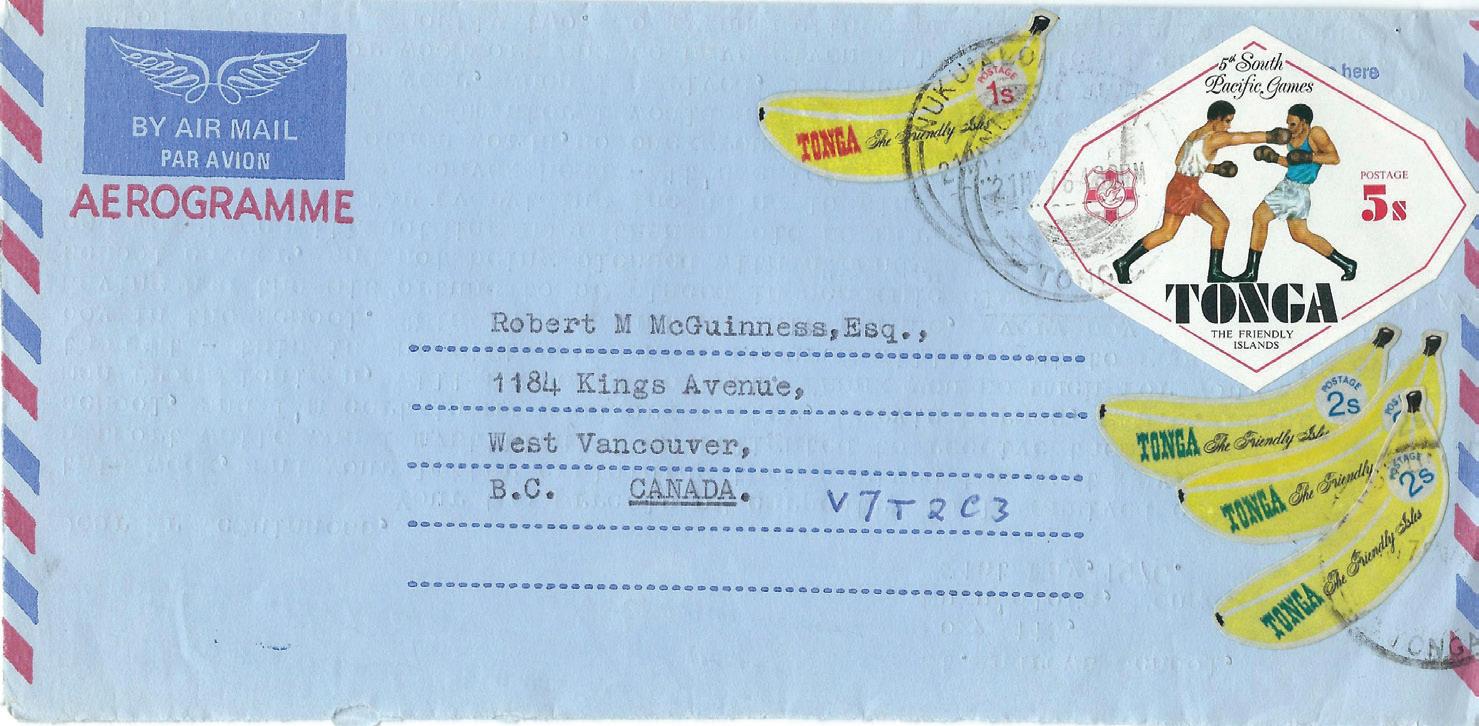

Canada ‘Free’ Prepaid Postcards
Canada Post has circulated free prepaid postcards (Figure 15) to households throughout Canada encouraging them to send a message to friends or family: ‘A short note can go a long way Please use this free postage paid postcard to reach out to a friend or family member, whether they’re in town or anywhere in Canada, courtesy of Canada Post. It’s always the right time to share special memories with the people you love. Make their day by sending this card from you to them.’
There were six different messages (in both English and French) on the reverse of the postcards: Sending Smiles, Missing I were there, From me to you, I miss you, sending hugs, I have been meaning to write. The postcards come in two forms, either with the message in English first or in French first Figure 13 large format Croxley aerogramme form sent from Tonga to Canada Figure 14 UK Imperial Air Mail aerogramme sent from Tonga to New Zealand in 1968 at the 5s rate. Figure 15 Canada Post Free Prepaid Postcard Sending Hugs
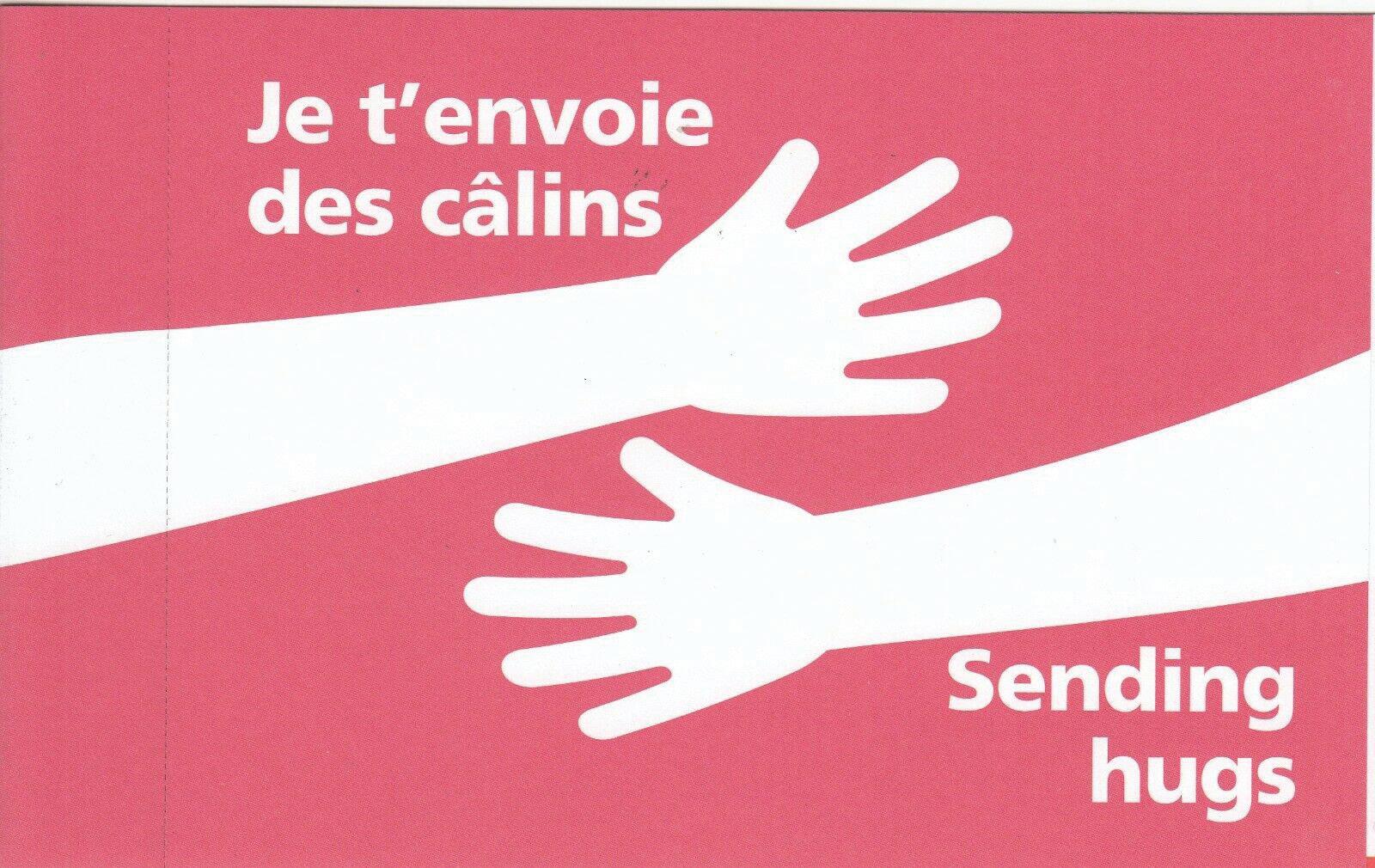
Ian McMahon



(meaning there are a total of twelve postcards to collect). The French first postcards were presumably distributed to households in predominantly French speaking areas. The postcards have the flag indicium (Figure 16) commonly found on current Canadian prepaid postcards which in this case is inscribed ‘For mailing in Canada and delivery in Canada’.
Australia Post Free Prepaid Postcard
Australia Post distributed free prepaid postcards (Figure 17-18) on the weekend of 16-17 January 2021 in a number of newspapers including the Weekend Australia, the Sunday Telegraph (Sydney), the Herald Sun (Melbourne), the Sunday Mail (Adelaide) and the Sunday Mail (Brisbane). The postcards were intended to be used to send Thank You messages to people who have played a part in the challenges of 2020 and the newspapers included a list of organisations to which people might write. The message on the cards reads: ‘Thank You. As I reflect on a difficult year, I think of you. I respect your courage, your sacrifice, your selflessness. This Australia Day, I am celebrating you.’ The indicium reads ‘No Stamp Required. Australia Post Supported Mail’. The postcards have the Australia Day Logo and the logo of the newspaper in which they were included (how many different postcards can you find?).
Figure 16 Canada Post Free Prepaid Postcard With Flag Indicium Figure 17 ‘Thank You’ Prepaid Postcard Figure 18 Reverse of ‘Thank You’ Postcard








